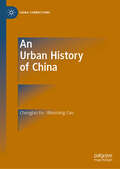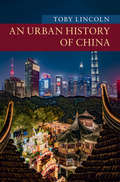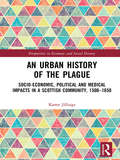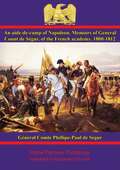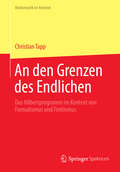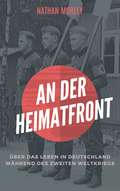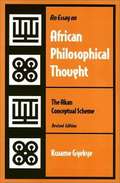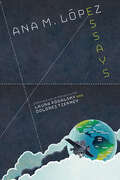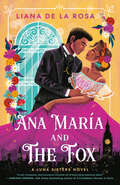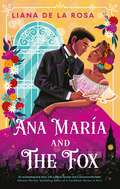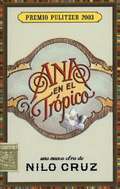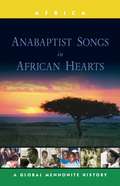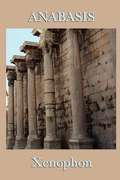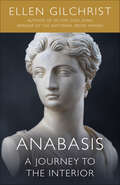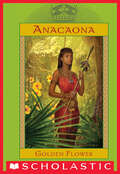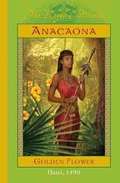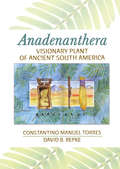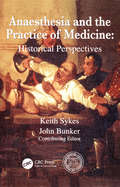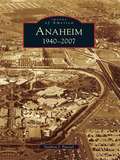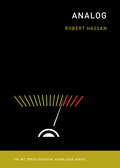- Table View
- List View
An Urban History of China (China Connections)
by Chonglan Fu Wenming CaoThis book considers urban development in China, highlighting links between China’s history and civilization and the rapid evolution of its urban forms. It explores the early days of urban dwelling in China, progressing to an analysis of residential environments in the industrial age. It also examines China’s modern and postmodern architecture, considered as derivative or lacking spiritual meaning or personality, and showcases how China's traditional culture underpins the emergence of China’s modern cities. Focusing on the notion of “courtyard spirit” in China, it offers a study of the urban public squares central to Chinese society, and examines the disruption of the traditional Square model and the rise and growth of new architectural models.
An Urban History of China (New Approaches to Asian History)
by Toby LincolnIn this accessible new study, Toby Lincoln offers the first history of Chinese cities from their origins to the present. Despite being an agricultural society for thousands of years, China had an imperial urban civilization. Over the last century, this urban civilization has been transformed into the world's largest modern urban society. Throughout their long history, Chinese cities have been shaped by interactions with those around the world, and the story of urban China is a crucial part of the history of how the world has become an urban society. Exploring the global connections of Chinese cities, the urban system, urban governance, and daily life alongside introductions to major historical debates and extracts from primary sources, this is essential reading for all those interested in China and in urban history.
An Urban History of The Plague: Socio-Economic, Political and Medical Impacts in a Scottish Community, 1500–1650 (Perspectives in Economic and Social History)
by Karen JillingsAs a medical, economic, spiritual and demographic crisis, plague affected practically every aspect of an early modern community whether on a local, regional or national scale. Its study therefore affords opportunities for the reassessment of many aspects of the pre-modern world. This book examines the incidence and effects of plague in an early modern Scottish community by analysing civic, medical and social responses to epidemics in the north-east port of Aberdeen, focusing on the period 1500–1650. While Aberdeen’s experience of plague was in many ways similar to that of other towns throughout Europe, certain idiosyncrasies in the city make it a particularly interesting case study, which challenges several assumptions about early modern mentalities.
An aide-de-camp of Napoleon. Memoirs of General Count de Ségur, of the French academy, 1800-1812
by Général Comte Phillipe-Paul de Ségur Comte Louis-Phillipe-Antoine-Charles de Ségur Mrs Harriette Anne Crookesley Patchett-MartinSeeing a regiment of Dragoons process through Paris in 1800, Philippe de Ségur decided to join the French cavalry at the ripe old age of 19, swiftly becoming part of Napoleon's headquarters staff. From then on, his career was to be unlike many of his contemporaries, for he was the son of a well-connected father and a protégé of Napoleon's confidante, Grand-Marshal Duroc. He saw service in all of the major Napoleonic campaigns, not just a courtier, distinguished in the crucible of the cavalry charge of Somosierra and also the battlefields of Hanau and Reims.For his service under Napoleon he was forced into retirement from the army and took to writing his memoirs and historical works. His scathing attack on Napoleon's conduct during the Russian campaign Histoire de Napoléon et de la grande armée pendant l'année 1812 provoked an uproar among Napoleonic loyalists and landed de Ségur in a duel. His further memoirs were published posthumously, a three volume account edited by his grandson, and this edited version was translated into English. Being at the hub of Napoleon's headquarters gave him the opportunity to see into most of the major events of the era and he recorded these with wit and an impressive eye for detail.These memoirs are a must for any enthusiast of the Napoleonic period.Author -- Général Comte Phillipe-Paul de Ségur, 1780-1873Editor - Comte Louis-Phillipe-Antoine-Charles de Ségur, b. 1838Translator - Mrs. Harriette Anne Crookesley Patchett-MartinText taken, whole and complete, from the edition published in New York, D. Appleton and company, 1895.Original Page Count - xxvi, 440 p.
An den Grenzen des Endlichen: Das Hilbertprogramm im Kontext von Formalismus und Finitismus (Mathematik im Kontext)
by Christian TappDer Mathematiker David Hilbert entwickelte mit seiner Beweistheorie ein Programm zur Grundlegung der Mathematik. In der ersten deutschsprachigen Monographie zum Thema bietet der Autor neue Deutungen des Hilbertprogramms. Ausgehend von den historischen Quellen stellt er die Frage neu, ob Hilbert eine formalistische Philosophie der Mathematik voraussetzte. Er macht die Fülle der Ideen sichtbar, die Hilbert und seine Schüler formulierten, diskutiert anspruchsvolle philosophische Implikationen und räumt mit einer Reihe von Fehlinterpretationen auf.
An der Heimatfront: Zu Hause während des zweiten Weltkrieges
by Nathan MorleyAn der Heimatfront bietet eine überzeugende und umfassende Darstellung des Alltagslebens in Deutschland während des zweiten Weltkrieges und zeigt auf, wie die Bevölkerung während dieser beispiellosen Notlage versucht hat, Normalität zu finden. Dieses Buch stützt sich auf eine Vielzahl von Quellen und berichtet von weltlichen bis hin zu bedeutsamen Themen wie dem Umgang mit der Rationierung, Kriminalität, Reisebeschränkungen, Bombenangriffen und der Schwankung der Zivilmoral, als sich der Krieg rasch gegen die Nazis richtet. Die offiziellen Zeitungen jener Jahre - darunter Das Reich, Völkischer Beobachter und Der Angriff – zeigen auf, wie und was die Öffentlichkeit von den Erfolgen und Misserfolgen ihrer Nation im Krieg erfuhr. Neben den umfangreichen Archiven deutscher Zeitungen, Polizeiberichten und Tagebüchern aus der Öffentlichkeit und der Politik tragen Periodenreden, private unveröffentlichte Briefe, Sendungen, Wochenschauen und Zeugenaussagen dazu bei, ein Bild vom täglichen Leben im nationalsozialistischen Deutschland zu zeichnen. Von der Reaktion auf die dramatischen Ereignisse an der Ostfront bis zu den häuslichen Schwierigkeiten beim Kochen mit synthetischen Lebensmitteln ist das Leben an der deutschen Heimatfront reichhaltig dokumentiert.
An essay on African philosophical thought The Akan conceptual scheme (Revised edition)
by Kwame GyekyeDefining the main principles of a distinct African philosophy, this work rejects the idea that an African philosophy consists simply of the work of Africans writing on philosophy. It argues that critical analyses of specific traditional African modes of thought are necessary to develop a distinctively African philosophy.
Ana M. López: Essays (SUNY series in Latin American Cinema)
by Ana M LópezAna M. López is one of the foremost film and media scholars in the world. Her work has addressed Latin American filmmaking in every historical period, across countries and genres—from early cinema to the present; from Brazil, Cuba, and Mexico to diasporic and Latinx cinemas in the United States; from documentary to melodrama to politically militant film. López's groundbreaking essays have transformed Latin American film studies, opening up new approaches, theoretical frameworks, and lines of investigation while also extending beyond cinema to analyze its connections with television, radio, and broader cultural phenomena. Bringing together twenty-five essays from throughout her career, including three that have been translated into English for this volume, Ana M. López is divided into three sections: the transnational turn in Latin American film studies; analysis of genre and modes; and debates surrounding race, ethnicity, and gender. Expertly curated and edited by Laura Podalsky and Dolores Tierney, the volume includes introductory material throughout to map and situate López's key interventions and to aid students and scholars less familiar with her work.
Ana María and The Fox (The Luna Sisters #1)
by Liana De la RosaA forbidden love between a Mexican heiress and a shrewd British politician makes for a tantalizing Victorian season. Ana María Luna Valdés has strived to be the perfect daughter, the perfect niece, and the perfect representative of the powerful Luna family. So when Ana María is secretly sent to London with her sisters to seek refuge from the French occupation of Mexico, she experiences her first taste of freedom far from the judgmental eyes of her domineering father. If only she could ignore the piercing looks she receives across ballroom floors from the austere Mr. Fox. Gideon Fox elevated himself from the London gutters by chasing his burning desire for more: more opportunities, more choices. For everyone. Now, as a member of Parliament, Gideon is on the cusp of securing the votes he needs to put forth a measure to abolish the Atlantic slave trade once and for all—a cause that is close to his heart as the grandson of a formerly enslaved woman. The charmingly vexing Ana María is a distraction he must ignore. But when Ana María finds herself in the crosshairs of a nefarious nobleman with his own political agenda, Gideon knows he must offer his hand as protection . . . but will this Mexican heiress win his heart as well?
Ana María and the Fox
by Liana De Rosa'An enchanting love story with a fierce, complex heroine and a swoon worthy hero. The Luna sisters have arrived . . . and the London season will never be the same' Adriana Herrera, USA Today bestselling author of A Caribbean Heiress in ParisA forbidden love between a Mexican heiress and a shrewd British politician makes for a tantalizing Victorian season.Ana María Luna Valdés has strived to be the perfect daughter, the perfect niece, and the perfect representative of the powerful Luna family. So when Ana María is secretly sent to London with her sisters to seek refuge from the French occupation of Mexico, she experiences her first taste of freedom far from the judgmental eyes of her domineering father. If only she could ignore the piercing looks she receives across ballroom floors from the austere Mr Fox.Gideon Fox elevated himself from the London gutters by chasing his burning desire for more: more opportunities, more choices. For everyone. Now, as a member of Parliament, Gideon is on the cusp of securing the votes he needs to put forth a measure to abolish the Atlantic slave trade once and for all - a cause that is close to his heart as the grandson of a formerly enslaved woman. The charmingly vexing Ana María is a distraction he must ignore.But when Ana María finds herself in the crosshairs of a nefarious nobleman with his own political agenda, Gideon knows he must offer his hand as protection . . . but will this Mexican heiress win his heart as well?'Truly a delight! A breath of fresh air in the landscape of historical romance' Sophie Jordan 'The perfect blend of romance and intrigue' Alicia Thompson 'Ana María is a feisty, fresh, and fabulous heroine and I fell hard for her swoony hero, Gideon. This book is pure magic!' Minerva Spencer 'A delicious slow burn romance with danger, intrigue, and sisterly bonding' Alexis Daria 'With plenty of humour, history and, of course, spicy love scenes, Ana María and the Fox, is an absolute must-read for fans of historical romance' Elizabeth Everett 'Fulfilled every historical romance craving I had and then some' Isabel Cañas
Ana en el Trópico
by Nilo Cruz Nacho Artime"Extraordinary and evocative, the stellar Anna in the Tropics is a work of art."--Christine Dolen, Miami HeraldThis lush romantic drama depicts a family of cigar makers whose loves and lives are played out against the backdrop of America in the midst of the Depression. Set in Ybor City (Tampa) in 1930, Cruz imagines the catalytic effect of the arrival of a new "lector" (who reads Tolstoy's Anna Karenina to the workers as they toil in the cigar factory) has on a Cuban-American family. Cruz celebrates the search for identity in a new land.
Anabaptist Songs in African Hearts: A Global Mennonite History (Global Mennonite History: Asia Ser.)
by John LappWhen church histories of Africa have been written, they've usually been done by Westerners. These writers have typically been missionaries or relief workers; their analyses and conclusions have reflected those perspectives. This book -- by contrast -- is written by Africans. Each writer is an African church leader or pastor, and they write about the emergence and development of the Mennonite and Brethren in Christ churches in the countries from which they come. "The story of God's work in Africa did not begin with the arrival of the missionaries, but rather -- from the African perspective -- their arrival continued, reinterpreted and re-shaped an ancient story," begins this honest collection. Themes of the churches claiming their particular expressions of faith, of achieving self-reliance, of coping with difficult governments, of discovering their gifts despite their material poverty, thread through the book. Anabaptist Songs in African Hearts is the third edition of the first volume in the Global Mennonite History Series.
Anabasis
by XenophonStranded deep in enemy territory, the Spartan general Clearchus and the other Greek senior officers were subsequently killed or captured by treachery on the part of the Persian satrap Tissaphernes. Xenophon, one of three remaining leaders elected by the soldiers, played an instrumental role in encouraging the Greek army of 10,000 to march north across foodless deserts and snow-filled mountain passes towards the Black Sea and the comparative security of its Greek shoreline cities.
Anabasis: A Journey to the Interior
by Ellen Gilchrist"Gilchrist's youthful enthusiasm for her heroine is evident throughout this appealing short novel, which should interest both adult and young adult readers." —Starr E. Smith, Library Journal Born into slavery, but taken on as an apprentice to the gentle genius Philokrates as a child, Auria has only known a life of wonder and kindness. A fount of knowledge and philosophy, Philokrates has spent the last few years teaching Auria all that he can about healing, nature, politics, geography and human nature. If only he had more time. When Philokrates succumbs to old age and passes away, Auria's devastation is all-encompassing. Alone in the world, more aware than ever that she is a slave and fated to a life of servitude, she refuses to leave her deceased mentor's side. But when she is called to help deliver a neighboring woman's child and discovers that, fifth in a line of only daughters, the baby is to be abandoned, Auria begins a journey that will change her life forever. Rescuing the girl, Auria leaves her town forever, determined to raise her on her own, and discovers a rebellion whose mission is to end slavery in Greece once and for all. Having found her own freedom, will Auria risk all that she has gained to free others?
Anabasis: Bdehn. Buch V-vii (Kiraz Historic Travels Archive Series)
by XenophonAn ancient Greek mercenary soldier&’s account of leading an army on a dangerous march from Babylon to the Black Sea. Hired by a Persian prince hoping to take the throne from his brother, Xenophon was one professional soldier in an army of many when disaster struck and their leaders were killed or captured, leaving them stranded. Along with two others chosen by their fellow soldiers, Xenophon would lead the army to safety on the &“March of the Ten Thousand.&” It was a harrowing journey, and they battled their way through harsh climates and hostile enemy territories—but eventually made it home. This memoir of the adventure, known for its clear language and directness, has become a classic for those interested in ancient Greek history and military culture.
Anacaona, Golden Flower: Golden Flower (The Royal Diaries)
by Edwidge DanticatThe New York Times–bestselling author and National Book Award finalist delivers a powerful Royal Diaries volume with the story of Haiti’s heroic queen.With her signature narrative grace, Edwidge Danticat brings Haiti’s beautiful queen Anacaona to life. Queen Anacaona was the wife of one of her island’s rulers, and a composer of songs and poems, making her popular among her people. Haiti was relatively quiet until the Spanish conquistadors discovered the island and began to settle there in 1492.The Spaniards treated the natives very cruelly, and when the natives revolted, the Spanish governor of Haiti ordered the arrests of several native nobles, including Anacaona, who was eventually captured and executed, to the horror of her people.“A gripping story that shows European invasion from a native Caribbean viewpoint . . . readers will connect with Danticat’s immediate, poetic language, Anacaona’s finely drawn growing pains, and the powerful, graphic story that adds a vital perspective to the literature about Columbus and European expansion in the Americas.” —Booklist“Explores the life of a proud, young Taíno woman as she grows into rulership, love, and motherhood . . . The arrival of Columbus’s explorers marks a major turning point in the novel, and Danticat shifts from a languid, poetic style to a tense, high gear that makes it difficult to put the book down.” —Historical Novel Society
Anacaona: The Golden Flower (The Royal Diaries)
by Edwidge DanticatDanticat brings Haiti's beautiful and heroic queen to life. Queen Anacaona's island was peaceful until the Spanish explorers conquered it in 1492. The conquistadors were cruel to Anacaona's people, and when they revolted, their queen was resigned to a tragic fate. Illustrations.
Anadenanthera: Visionary Plant of Ancient South America
by Constantino M Torres David B RepkeA multidisciplinary study of pre-Columbian South America-centering on the psychoactive plant genus AnadenantheraAs cultures formed and evolved in pre-Columbian South America, Anadenanthera became one of the most widely used shamanic inebriants. Anadenanthera: Visionary Plant of Ancient South America is more than a comprehensive reference on shamanic visionary substances; it is a useful tool for archeologists and pre-Columbian art historians. This thorough book examines the ritual and cultural use of Anadenanthera from prehistory to the present, along with its botany, chemistry, pharmacology, anthropology, and archeology.The earliest evidence for the use of psychoactive plants in South America is provided by remains of seeds and pods recovered from archeological sites four millennia old. Various preparations were derived from it with the intent of being a shamanic inebriant. Inhaled through the nose, smoked in pipes or as cigars, and prepared in fermented drinks, Anadenanthera served a central role in the cultural development of indigenous societies in South America. Anadenanthera: Visionary Plant of Ancient South America explores the full spectrum of information gleaned from research, covering numerous archeological sites in the Andean region, as well as discussing Amazonian shamanic rituals and lore. Analyses of the artistic expressions within the decorations of associated ceremonial paraphernalia such as ritual snuffing tubes and snuff trays are included. The text is richly illustrated with photographs and images of decorated ritual implements, and provides a comprehensive bibliography.Anadenanthera: Visionary Plant of Ancient South America explores: botanical aspects, taxonomy, and geographical distribution of Anadenanthera ethnographical, historical, and traditional aspects of Anadenanthera use chemical and pharmacological investigations of the genus and the various visionary preparations derived from it-with emphasis on the biologically active constituents theories of the mechanisms of action of the active tryptamines and carboline alkaloids comparisons of wood anatomy, morphology, and percentage of alkaloid content evaluation of stylistic and iconographic traitsAnadenanthera: Visionary Plant of Ancient South America is a thorough, useful resource for archeologists, anthropologists, chemists, researchers, pre-Columbian art historians, and any layperson interested in pre-Columbian art, archeology, or visionary plants.
Anaesthesia and the Practice of Medicine: Historical Perspectives
by Keith Sykes John P BunkerWritten by two anaesthetists, one British and one American, this unique book focuses on the transatlantic story of anaesthesia. The authors have both worked at the two hospitals where the first general anaesthetics for surgery were given in 1846, Massachusetts General Hospital in Boston, Massachusetts and University College Hospital, London. Each with more than fifty years' experience of working in anaesthesia, they combine their knowledge and expertise to offer a fresh outlook on the development of anaesthesia through the ages.This highly informative and intriguing text details the origins of anaesthesia, outlines the different techniques of anaesthesia and traces its progress with illuminating and enlightening commentaries. This is a fascinating book which considers the role key figures have played in developing anaesthesia including, Queen Victoria, William Morris, La Condamine, Bjorn Ibsen and Henry Beecher.Broken down into four sections, which are divided into easy-to-read chapters and filled with top quality photographs, this book makes compelling reading. It is recommended to all those interested in the history and development of medicine through the ages, and is of particular interest to anaesthetists. More than just the science of anaesthesia, this is the story about the people and personalities who have made anaesthesia what it is today.
Anaheim: 1940-2007
by Stephen J. FaesselAfter the developments that the World War II era brought to the small agricultural community of Anaheim, the major transformation arrived in 1955. Anaheim changed forever from a sleepy and proud little town into the center for entertainment and tourism in Southern California with the arrival of Disneyland. Other national and regional businesses and franchises arrived in and around this Orange County anchor city--including the California Angels baseball club, the Anaheim Convention Center, and such aerospace giants as Boeing and Rockwell International--and Anaheim grew exponentially. This collection of more than 200 vintage and contemporary images depict the results of Anaheim's far-sighted elected and business leaders, who nurtured the city from its agrarian roots and made it into one of the nation's fastest growing cities in the 1960s.
Analects
by David HintonWhile Confucius failed in his lifetime to rescue a crumbling civilization with his teachings, he was to become the most influential sage in human history. His thought, still remarkably current and even innovative after 2500 years, survives here in The Analects - a collection of brief aphoristic sayings that has had a deeper impact on more people's lives over a longer period of time than any other book in human history.Formulated in the ruins of a society that had been founded on untenable spiritualistic concepts of governance, Confucius' philosophy postulated a humanistic social order that has survived as China's social ideal ever since. Beginning with the realization that society is a structure of human relationships, Confucius saw that in a healthy society this structure must be a selfless weave of caring relationships. Those caring relationships are a system of "ritual" that people enact in their daily lives, thus infusing the secular with scared dimensions.Highly regarded for the poetic fluency he brings to his award-winning work, David Hinton is the first twentieth-century translator to render the four central masterworks of ancient Chinese thought: Chuang Tzu, Mencius, The Analects, and Tao te Ching (forthcoming). HIs new versions are not only inviting and immensely readable, but they also apply a much-needed consistency to key terms in these texts, lending structural links and philosophical rigor heretofore unavailable in English. Breathing new life into these originary classics, Hinton's translations will stand as the definitive series for our era.
Analise
by Lisa GregoryA STORMY SURRENDER TO LOVE... He swept down from the North, disguised as a Confederate officer, determined to woo the belle of New Orleans, Analise Caldwell-and wrest from her the military secrets her father held. Now, to save a life, the raven-haired Analise must trade her innocence to this Union spy and major, the iron-willed Mark Schaeffer, the man who treats her like pirate booty and possesses her with a jealous fury. Torn from family and friends, burning with a tenderness she dare not speak, the spirited beauty must survive in a battle-scarred world and fight for the tempestuous love of her captor. For Analise has imprisoned the wild heart of her Yankee foe...and although the city of Spanish moss and French elegance has surrendered -the war of flame-bright passions has just begun...
Analog (The MIT Press Essential Knowledge series)
by Robert HassanWhy, surrounded by screens and smart devices, we feel a deep connection to the analog—vinyl records, fountain pens, Kodak film, and other nondigital tools.We&’re surrounded by screens; our music comes in the form of digital files; we tap words into a notes app. Why do we still crave the &“realness&” of analog, seeking out vinyl records, fountain pens, cameras with film? In this volume in the MIT Press Essential Knowledge series, Robert Hassan explores our deep connection to analog technology. Our analog urge, he explains, is about what we&’ve lost from our technological past, something that&’s not there in our digital present. We&’re nostalgic for what we remember indistinctly as somehow more real, more human. Surveying some of the major developments of analog technology, Hassan shows us what&’s been lost with the digital. Along the way, he discusses the appeal of the 2011 silent, black-and-white Oscar-winning film The Artist; the revival of the non-e-book book; the early mechanical clocks that enforced prayer and worship times; and the programmable loom. He describes the effect of the typewriter on Nietzsche&’s productivity, the pivotal invention of the telegraph, and the popularity of the first televisions despite their iffy picture quality.The transition to digital is marked by the downgrading of human participation in the human-technology relationship. We have unwittingly unmoored ourselves, Hassan warns, from the anchors of analog technology and the natural world. Our analog nostalgia is for those ancient aspects of who and what we are.
Analog Superpowers: How Twentieth-Century Technology Theft Built the National Security State
by Katherine C. EpsteinA gripping history that spans law, international affairs, and top-secret technology to unmask the tension between intellectual property rights and national security. At the beginning of the twentieth century, two British inventors, Arthur Pollen and Harold Isherwood, became fascinated by a major military question: how to aim the big guns of battleships. These warships—of enormous geopolitical import before the advent of intercontinental missiles or drones—had to shoot in poor light and choppy seas at distant moving targets, conditions that impeded accurate gunfire. Seeing the need to account for a plethora of variables, Pollen and Isherwood built an integrated system for gathering data, calculating predictions, and transmitting the results to the gunners. At the heart of their invention was the most advanced analog computer of the day, a technological breakthrough that anticipated the famous Norden bombsight of World War II, the inertial guidance systems of nuclear missiles, and the networked “smart” systems that dominate combat today. Recognizing the value of Pollen and Isherwood’s invention, the British Royal Navy and the United States Navy pirated it, one after the other. When the inventors sued, both the British and US governments invoked secrecy, citing national security concerns. Drawing on a wealth of archival evidence, Analog Superpowers analyzes these and related legal battles over naval technology, exploring how national defense tested the two countries’ commitment to individual rights and the free market. Katherine C. Epstein deftly sets out Pollen’s and Isherwood’s pioneering achievements, the patent questions raised, the geopolitical rivalry between Britain and the United States, and the legal precedents each country developed to control military tools built by private contractors. Epstein’s account reveals that long before the US national security state sought to restrict information about atomic energy, it was already embroiled in another contest between innovation and secrecy. The America portrayed in this sweeping and accessible history isn’t yet a global hegemon but a rising superpower ready to acquire foreign technology by fair means or foul—much as it accuses China of doing today.
Analog und Digital: schriften zur philosophie des machens
by Otl AicherOtl Aicher (1922 –1991) war einer der herausragenden Vertreter des modernen Designs, er war Mitbegründer der legendären Hochschule für Gestaltung Ulm (HfG). Der heute geläu_ ge Begriff der visuellen Kommunikation ist auf ihn zurückzuführen. Was er seit den 1950er Jahren geschaffen hat, erinnert sei z. B. an die Piktogramme für die Olympischen Sommerspiele München 1972, gehört zu den ganz großen Leistungen der visuellen Kultur unserer Zeit.Ein wesentlicher Aspekt der Arbeiten von Aicher ist deren Verankerung in einer von Denkern wie Ockham, Kant oder Wittgenstein inspirierten „Philosophie des Machens“, die die Voraussetzungen und Ziele sowie die Gegenstände und Ansprüche von Gestaltung zum Thema hat. Aichers Schriften zu Fragen des Designs von der visuellen Gestaltung bis hin zur Architektur liegen in diesem Band in geschlossener Form vor.Wenn Aicher das Analoge und Konkrete dem Digitalen und Abstrakten vorzieht, tut er dies mit philosophischer Absicht. Er relativiert die Rolle der reinen Vernunft. Er kritisiert den Rationalismus der Moderne als Ergebnis der Vorherrschaft des bloß abstrakten Denkens. Wer das Abstrakte dem Konkreten vorzieht, missversteht nicht nur die wechselseitige Abhängigkeit von Begriff und Anschauung. Er schafft nach Aichers Urteil auch eine falsche Hierarchie, eine Rangordnung, die kulturell verhängnisvoll ist. Das digitale, Abstrakte ist nicht höher, größer und wichtiger als das Analoge, Konkrete.Wilhelm Vossenkuhl
